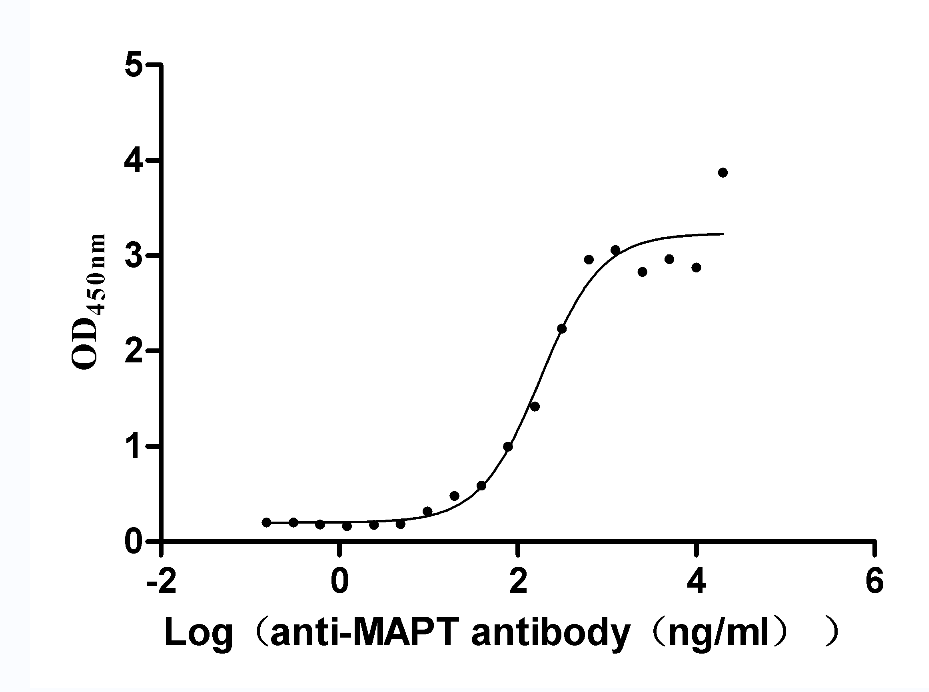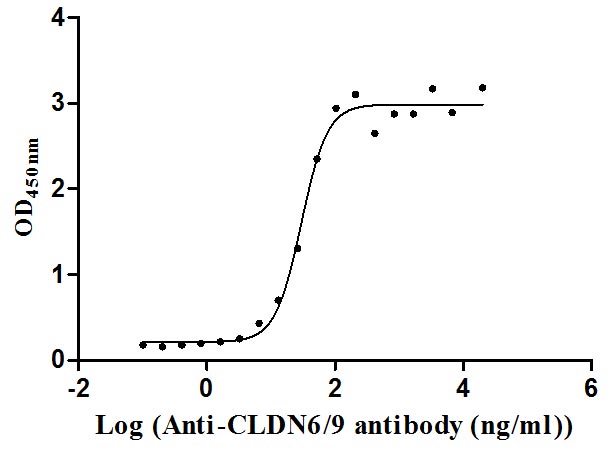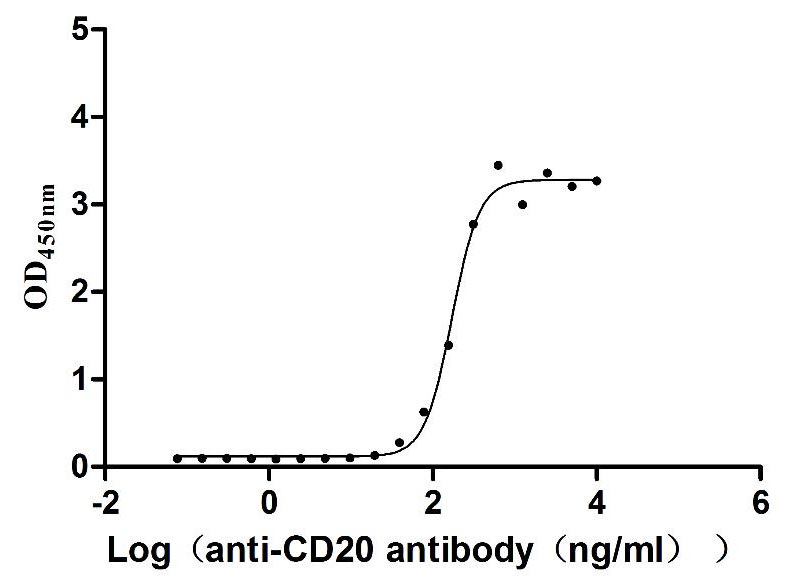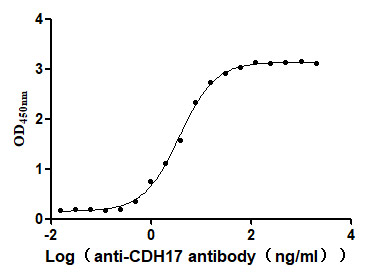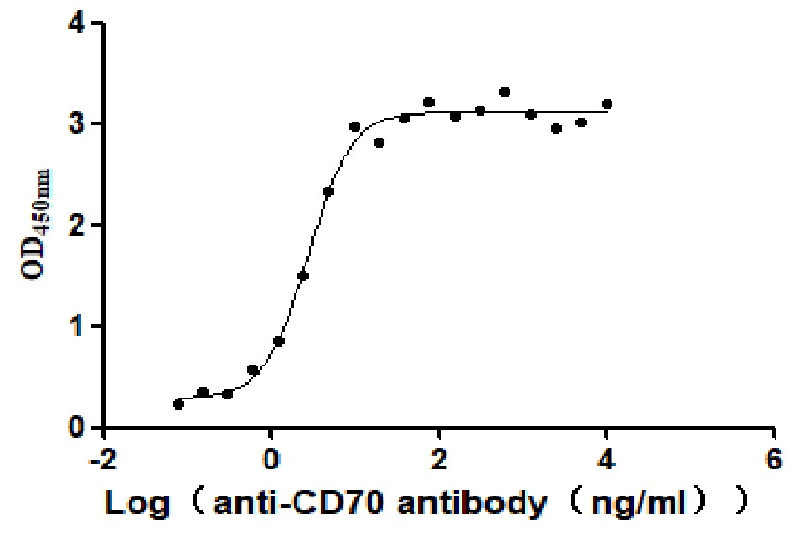Recombinant Human Cytokine receptor-like factor 2 (CRLF2), partial, Biotinylated
-
中文名稱:Recombinant Human Cytokine receptor-like factor 2 (CRLF2), partial, Biotinylated
-
貨號:CSB-MP005983HU-B
-
規格:¥2028
-
圖片:
-
其他:
產品詳情
-
純度:Greater than 95% as determined by SDS-PAGE.
-
生物活性:Not Test
-
基因名:
-
Uniprot No.:
-
種屬:Homo sapiens (Human)
-
蛋白長度:Partial
-
來源:Mammalian cell
-
分子量:28.6 kDa
-
表達區域:25-231aa
-
氨基酸序列GAAEGVQIQIIYFNLETVQVTWNASKYSRTNLTFHYRFNGDEAYDQCTNYLLQEGHTSGCLLDAEQRDDILYFSIRNGTHPVFTASRWMVYYLKPSSPKHVRFSWHQDAVTVTCSDLSYGDLLYEVQYRSPFDTEWQSKQENTCNVTIEGLDAEKCYSFWVRVKAMEDVYGPDTYPSDWSEVTCWQRGEIRDACAETPTPPKPKLSK
Note: The complete sequence may include tag sequence, target protein sequence, linker sequence and extra sequence that is translated with the protein sequence for the purpose(s) of secretion, stability, solubility, etc.
If the exact amino acid sequence of this recombinant protein is critical to your application, please explicitly request the full and complete sequence of this protein before ordering. -
蛋白標簽:C-terminal 10xHis-Avi-tagged
-
產品提供形式:Liquid or Lyophilized powder
Note: We will preferentially ship the format that we have in stock, however, if you have any special requirement for the format, please remark your requirement when placing the order, we will prepare according to your demand. -
緩沖液:If the delivery form is liquid, the default storage buffer is Tris/PBS-based buffer, 5%-50% glycerol. If the delivery form is lyophilized powder, the buffer before lyophilization is Tris/PBS-based buffer, 6% Trehalose, pH 8.0.
-
復溶:We recommend that this vial be briefly centrifuged prior to opening to bring the contents to the bottom. Please reconstitute protein in deionized sterile water to a concentration of 0.1-1.0 mg/mL.We recommend to add 5-50% of glycerol (final concentration) and aliquot for long-term storage at -20℃/-80℃. Our default final concentration of glycerol is 50%. Customers could use it as reference.
-
儲存條件:Store at -20°C/-80°C upon receipt, aliquoting is necessary for mutiple use. Avoid repeated freeze-thaw cycles.
-
保質期:The shelf life is related to many factors, storage state, buffer ingredients, storage temperature and the stability of the protein itself.
Generally, the shelf life of liquid form is 6 months at -20°C/-80°C. The shelf life of lyophilized form is 12 months at -20°C/-80°C. -
貨期:Basically, we can dispatch the products out in 3-7 working days after receiving your orders. Delivery time may differ from different purchasing way or location, please kindly consult your local distributors for specific delivery time.
-
注意事項:Repeated freezing and thawing is not recommended. Store working aliquots at 4℃ for up to one week.
-
Datasheet & COA:Please contact us to get it.
相關產品
靶點詳情
-
功能:Receptor for thymic stromal lymphopoietin (TSLP). Forms a functional complex with TSLP and IL7R which is capable of stimulating cell proliferation through activation of STAT3 and STAT5. Also activates JAK2. Implicated in the development of the hematopoietic system.
-
基因功能參考文獻:
- Family-based whole genome analysis of a family with hereditary pulmonary alveolar proteinosis revealed a homozygous deletion that disrupts CSF2RA, CRLF2, and IL3RA gene in the pseudoautosomal region of the X chromosome in the affected child and one of asymptomatic siblings. PMID: 28233860
- TSLP expression on the basophil membrane of patients with severe asthma was not significantly different from healthy controls. PMID: 29402810
- high CRLF2 expression works with the IKZF1 deletion to drive oncogenesis of acute lymphoblastic leukemia PMID: 27391346
- this study shows that CRLF2 over-expression is a poor prognostic marker in children with high risk T-cell acute lymphoblastic leukemia PMID: 27449287
- data suggest that this high frequency of genetic aberrations in the context of a high CRLF2 expression could contribute to the high risk of relapse in P2RY8/CRLF2- and IGH/CRLF2-positive acute lymphoblastic leukemia. PMID: 28371317
- CRLF2 overexpression is associated with childhood B-cell acute lymphoblastic leukemia. PMID: 27637012
- CRLF2 gene rearrangement is associated with acute lymphoblastic leukemia. PMID: 28033648
- TSLPR levels were found to be significantly higher in asthmatic than in nonasthmatic children. TSLPR expression in non-allergic asthmatic and allergic asthmatic groups was found to be significantly higher than in non-allergic nonasthmatic group PMID: 26999524
- In adult B-cell acute lymphoblastic leukemia without recurrent fusion genes , high CRLF2 expression is associated with distinct clinico-biological features and an unfavourable prognosis PMID: 26754556
- CD4+ T cells from atopic dermatitis patients directly interacted with TSLP to produce a higher amount of IL-4 than those from normal subjects, and this action was attenuated with anti-TSLPR antibody PMID: 26288354
- The levels of mRNA for TSLP and TSLPR were significantly elevated in parotid gland tissues from the KD group as compared to the control group. PMID: 25676453
- Differences exist in the genetic profiles of Down syndrome-associated acute lymphoblastic leukemia patients in Japan and in Western countries, and that P2RY8-CRLF2 and EBF1 deletions may cooperate in leukemogenesis in a subset of Japanese DS-ALL patients. PMID: 25044358
- CRLF2 overexpression (OE) was detected in 30 (18%) of 167 patients, the P2RY8-CRLF2 fusion was identified in only 3 (1.8%) of 167 patients, all of which demonstrated CRLF2 OE. PMID: 24935070
- we report noncysteine in-frame mutations in IL7R and CRLF2 located in a region of the transmembrane domain closer to the cytosolic domain in acute lymphoblastic leukemias PMID: 24787007
- The TSLPR in blood plateltes promotes platelet activation via activating the PI3K/AKT pathway. PMID: 24356513
- both IKZF1 deletions and IGH@-CRLF2 are associated with an increased risk of treatment failure in adult acute lymphoblastic leukemia PMID: 24018820
- Data indicate that CD66c is frequently expressed in CRLF2-positive as well as hypodiploid cases. PMID: 24231528
- Higher cumulative incidence of relapse was found for BCR-ABL1-like and IKZF1-deleted, but not CRLF2-high, cases relative to remaining BCP-ALL cases. PMID: 23974192
- IKZF1 deletions and CRLF2-high expression predicted poor outcomes in patients with HR-ALL but not in patients with SR-ALL in our Japanese cohort PMID: 23804397
- Results show no clinical or laboratory difference between those with high and low crlf2 expression PMID: 23145900
- P2RY8-CRLF2-positive clones do not have the necessary proliferative or selective advantage to evolve into a disease-relevant relapse clone. PMID: 23091296
- Neither CRLF2 nor JAK2 were predictors for worse prognosis in children with Down's syndrome and acute lymphoblastic leukemia. PMID: 22441210
- Poor prognosis for P2RY8-CRLF2 fusion but not for CRLF2 over-expression in children with intermediate risk B-cell precursor acute lymphoblastic leukemia. PMID: 22484421
- CRLF2-overexpressing B-cell acute lymphoblastic leukemias have a gain-of-function CRLF2 F232C mutation or activating mutations in JAK2. PMID: 22915648
- CRLF2-deregulation and IGH locus translocations represent distinct subtypes of adolescent and adult acute lymphoblastic leukemia. PMID: 22851563
- This review sums up diverse mechanisms that mediate TSLP/TSLP receptor-signalling network in chronic airway diseases. PMID: 22168549
- CRLF2 overexpression is associated with acute lymphoblastic leukemia. PMID: 22297722
- High CRLF2 expression is associated with a very poor outcome in high-risk, but not standard-risk, acute lymphoblastic leukemia. PMID: 22368272
- Data indicate that overexpression of CRLF2 was not observed in adult patients with Ph-positive or T-ALL but was limited to B-ALL patients with a normal diagnostic karyotype. PMID: 21457190
- review highlights the current knowledge of the incidence, prognostic significance, and biology of CRLF2-overexpressing ALL and future directions for development of targeted therapies PMID: 22150304
- TSLPR expression was significantly higher in the inflammatory infiltrate and in the epithelial cells of chronic rhinosinusitis with or without nasal polyps PMID: 21978707
- Integrated genomic profiling has identified potential therapeutic targets in acute lymphoblastic leukemia, including aberrant cytokine receptor signaling mediated by rearrangements and mutation of CRLF2 PMID: 21169835
- Deregulated expression of CRLF2 (CRLF2-d) arises via its juxtaposition to the IGH@ enhancer or P2RY8 promoter. Among 865 BCP-ALL children treated on MRC ALL97, 52 (6%) had CRLF2-d, but it was more prevalent among Down syndrome patients (54%). PMID: 21106984
- increased CRLF2 expression associates with JAK2 mutation, a combination that transforms hematopoietic cells, suggesting that mutant JAK2 and CRLF2 may cooperate to contribute to B-progenitor acute lymphoblastic leukemia formation [review] PMID: 20807819
- The genotype and allele frequencies of the g.33G>C and g.19646A>G of the TSLPR gene were significantly associated in the atopic asthma patients rather than in the non-atopic asthma patients PMID: 20663412
- Studies indicate that of 19 total CRLF2 breakpoints, 7 are directly at CpGs and breakpoints are much closer to CpGs than expected by random chance. PMID: 20847213
- Study reports an extremely high incidence of relapse (71% +/- 19%) in non-high-risk precursor B-cell acute lymphoblastic leukemia patients with P2RY8-CRLF2 rearrangement. PMID: 20378752
- Activation of CRLF2 expression, mutation of of JAK1 or JAK2, and alterations of IKZF1 cooperate to promote B-cell leukemogenesis. PMID: 20139093
- The hymic stromal lymphopoietin receptor is involved in the pathogenesis of allergic asthma through the activation of human airway smooth muscle cells by t hymic stromal lymphopoietin PMID: 20483734
- human TSLP receptor requires the function of JAK1 and JAK2 for STAT activation PMID: 20128689
- Activating mutation in the TSLPR gene in B-cell precursor lymphoblastic leukemia; results indicate that TSLPR activation may occur independently of a JAK2R683 mutation and that TSLPR can also be the site of a point mutation PMID: 19907440
- Our data indicate that epithelial cells express TSLPR and that TSLP induces bronchial epithelial cell proliferation and increases injury repair through IL-13 production. PMID: 20236697
- Induced homodimerization of receptor chimeras containing the transmembrane and cytoplasmic domains of both human and mouse TSLP receptors is not sufficient for driving cell proliferation. PMID: 20096461
- Results implicate CRLF2 as an important factor in precursor B-cell acute lymphoblastic leukemia with diagnostic, prognostic, and therapeutic implications. PMID: 20018760
- Results suggest that the majority of DS children with ALL may benefit from therapy blocking the CRLF2/JAK2 pathways. PMID: 19965641
- Expression of TSLP receptor was upregulated on atopic DCs primed with H22-Fel d 1 through a pathway regulated by FcgammaRI-associated signaling components. PMID: 20109752
- The presence of TSLP receptors is unexpectedly demonstrated on activated human CD4-positive T cells. PMID: 17513717
- A causal role of CRLF2 overexpression in lymphoid transformation. PMID: 19641190
- report a recurring interstitial deletion of the pseudoautosomal region 1 of chromosomes X and Y in B-progenitor acute lymphoblastic leukemia that juxtaposes the first, noncoding exon of P2RY8 with the coding region of CRLF2. PMID: 19838194
顯示更多
收起更多
-
亞細胞定位:[Isoform 1]: Cell membrane; Single-pass type I membrane protein.; [Isoform 2]: Secreted.
-
蛋白家族:Type I cytokine receptor family, Type 5 subfamily
-
組織特異性:Expressed in heart, skeletal muscle, kidney and adult and fetal liver. Primarily expressed in dendrites and monocytes. Weakly expressed in T-cells.
-
數據庫鏈接:
Most popular with customers
-
Recombinant Human B- and T-lymphocyte attenuator (BTLA), partial (Active)
Express system: Mammalian cell
Species: Homo sapiens (Human)
-
Recombinant Human IGF-like family receptor 1 (IGFLR1), partial (Active)
Express system: Mammalian cell
Species: Homo sapiens (Human)
-
Recombinant Human Claudin-18.2 (CLDN18.2)-VLPs (Active)
Express system: Mammalian cell
Species: Homo sapiens (Human)
-
Recombinant Rat Microtubule-associated protein tau (Mapt) (Active)
Express system: Mammalian cell
Species: Rattus norvegicus (Rat)
-
Recombinant Human Claudin-9 (CLDN9)-VLPs (Active)
Express system: Mammalian cell
Species: Homo sapiens (Human)
-
Recombinant Dog B-lymphocyte antigen CD20 (MS4A1)-VLPs (Active)
Express system: Mammalian cell
Species: Canis lupus familiaris (Dog) (Canis familiaris)
-
Recombinant Human Cadherin-17 (CDH17), partial (Active)
Express system: Mammalian cell
Species: Homo sapiens (Human)
-
Recombinant Human CD70 antigen (CD70), partial (Active)
Express system: Mammalian cell
Species: Homo sapiens (Human)



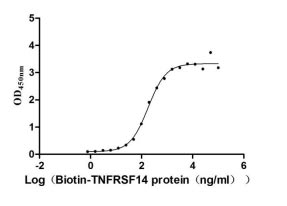
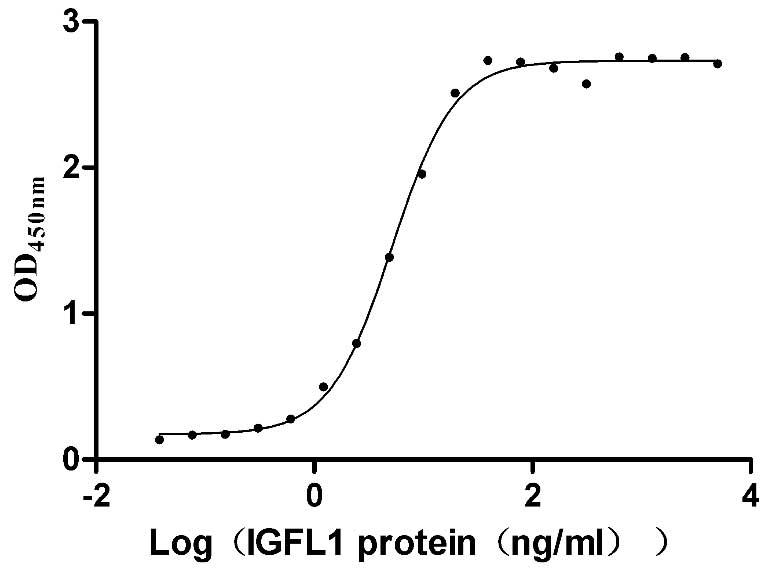
-AC1.jpg)
